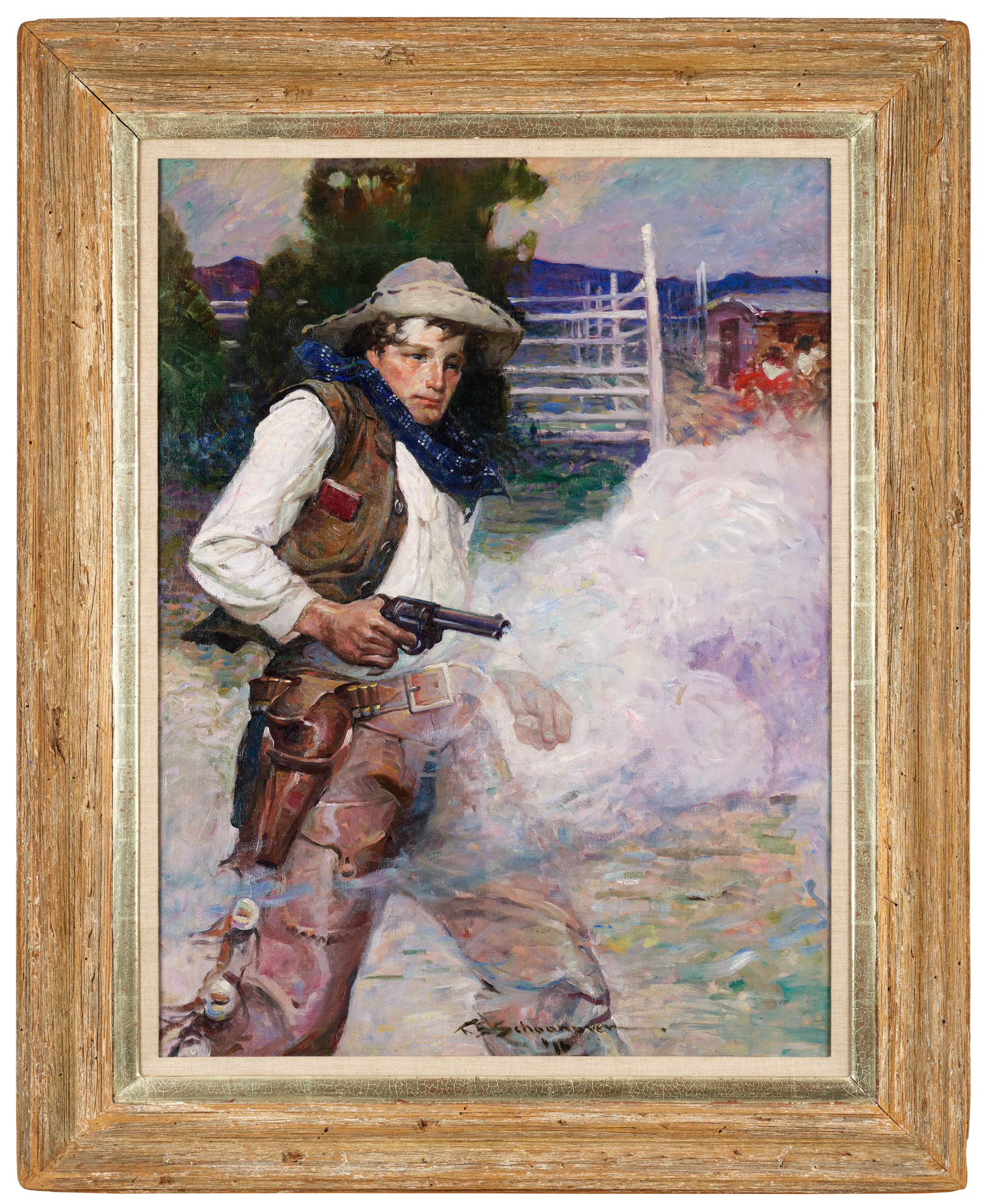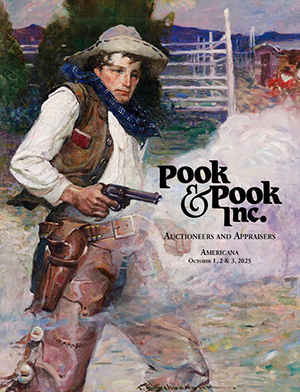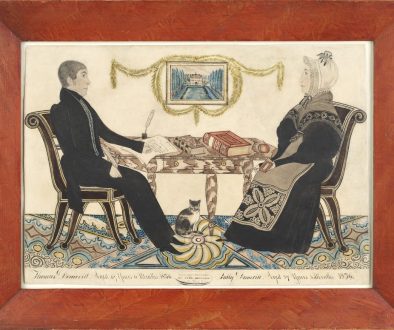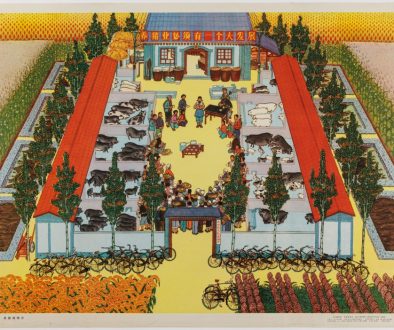Randerson Kills Prickett
Lot 428, the oil on canvas Randerson Kills Prickett, and the lot gracing the cover of our October 2025 Americana catalog, is not only one of the finest paintings of an Old West gunslinger created, it is also one of the finest works to come out of the Brandywine School of illustration artists.
Frank Earle Schoonover (b. 1877, Oxford, New Jersey) studied illustration under Howard Pyle at the Drexel Institute in Philadelphia. It was the Golden Age of Illustration, when artists worked closely with authors to create powerful visual storytelling to enhance books and commercial projects. In 1900, Pyle moved his program to his studio in Wilmington, Delaware, and Schoonover moved with him. Schoonover’s new studio was in a building shared by fellow artists N.C. Wyeth, Thorton Oakley, and Harvey Dunn.[1] Pyle taught his students to “live their work”, and to explore American history and culture to fuel their imagination. Frank Schoonover sought to capture the action and adventure of the Western frontier in America and Canada. He painted strong characters: Native Americans, cowboys, trappers, and explorers. “I never painted a weakling,” proclaimed Schoonover.[2] He excelled in portraying action, capturing the thrill and the movement of a scene. Cortlandt Schoonover describes his father as “above all, an artist of action.”[3]
In 1905, Schoonover embarked on a lengthy research trip to Denver, Colorado and Butte, Montana on assignment for McClure’s magazine. In Butte, “Schoonover also made the acquaintance of Rex Randerson, a local sheriff, who owned a picturesque though bony horse.”[4] Charles Alden Seltzer “used this character in a story based largely on Schoonover’s observations.”[5] The book, The Range Boss, was published in 1916. The story revolves around the character Rex Randerson, a range boss who helps new owner Ruth Harkness manage her ranch. It is a frontier tale full of bravery and action, gunslinging and cattle rustlers, in which the hero, in the end, gets the girl.
This painting shows range boss Rex Randerson shooting a cattle rustler named Prickett, and was captioned “The twilight was split by a red streak.”[6] It is one of several notable illustrations created for the book. (The most famous, Randerson On Patches, was reworked in 1926 into an iconic poster for the Colt Firearms Company.[7])
The painting Randerson Kills Prickett is a Frank Schoonover masterwork. It captures the moment Randerson fires his revolver. Captured in loose, impressionistic brushstrokes, his right arm and shoulder recoil from the shot. His stance is solid, stabilized by his forward leg and left hand, which is clenched into a fist and exquisitely outlined behind a veil of gun smoke. The gun smoke is a thing of beauty, a cloud of shimmering color. (Schoonover painted in the winters in the Poconos, in Bushkill, Pennsylvania, with Pennsylvania Impressionist Edward Redfield, who taught him to mix a bit of vermilion into white forms such as snow.[8]) The light, color, and action combine into a painting at the top of Schoonover’s oeuvre. Visible in the upper right is Schoonover’s unwritten signature, the touch of “Schoonover Red”, a splash of cadmium red added to heighten the drama and intensity of a scene.[9]
Please join us for our Americana auction October 1-3, and for our preview, September 27, 29, and 30, to see this painting, part of the Randy Anderson Collection of over twenty works from fellow members of the Brandywine School, including Gayle Porter Hoskins, Stanley Massey Arthurs, N.C. Wyeth, and others.
By: Cynthia Beech Lawrence
[1] Schoonover, Cortlandt. Frank Schoonover. Illustrator of the North American Frontier. New York: Watson-Guptill, 1976.
[2] Schoonover, Cortlandt. Frank Schoonover, p. 13.
[3] Schoonover, Cortlandt. Frank Schoonover, p. 13.
[4] Schoonover, Cortlandt. Frank Schoonover, pp. 23, 24.
[5] Schoonover, Cortlandt. Frank Schoonover, pp. 24.
[6] Schoonover, John. Louise Schoonover Smith with LeeAnn Dean. Frank E. Schoonover Catalogue Raisonne. New Castle, Delaware: Oak Knoll Press, 2009. No. 726.
[7] Schoonover, John. Catalogue Raisonne, Nos. 733 and 1419.
[8] Schoonover, Cortlandt. Frank Schoonover, p.39.
[9] Schoonover, Cortlandt, Frank Schoonover, p. 39.





